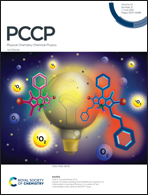Conversion of methanol on rutile TiO2 (110) and tungsten oxide clusters: 1. population of defect-dependent thermal reaction pathways†
Abstract
Tungsten oxide clusters deposited on rutile TiO2 (110) single crystals were used as a model system for heterogenous oxide-oxide bifunctional catalysts. The population of different thermal reaction routes in methanol conversion in the presence of preadsorbed oxygen was probed under UHV conditions. By temperature programmed reaction spectroscopy, we have identified three thermal reaction channels, namely the deoxygenation under formation of methane, the partial oxidation forming formaldehyde and the condensation route under desorption of ethane and dimethyl ether. The specific local reaction environment at the oxidic surface was found to be key for the population of the different reaction channels as exhibited by the introduction of Lewis acidic and basic sites (especially (WO3)n clusters) and available charge carriers such as Ti3+. Especially the amount of bulk Ti3+ interstitials, that can partially transfer charge towards the tungsten oxide clusters at the TiO2 surface, was found to be a key parameter that enables a relatively high methanol conversion in thermal reactions. It turned out that the deoxygenation is by far the most dominant reaction followed by the partial oxidation. The condensation is observed only in low amounts under special conditions, but is an interesting example for reactivity at defect sites.



 Please wait while we load your content...
Please wait while we load your content...